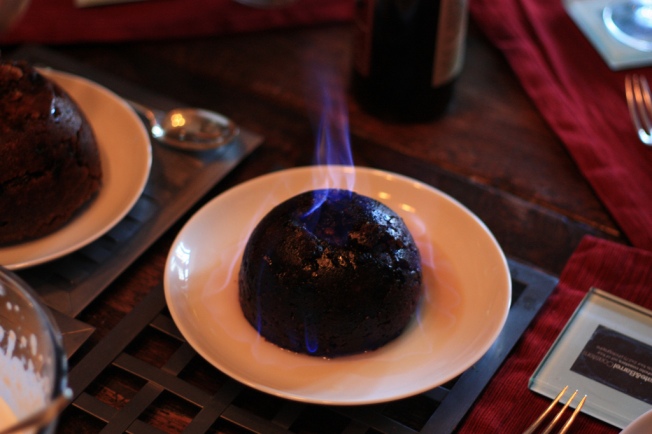
Figgy pudding served alight at a holiday celebration.
By Garland Mason
This time of year is particularly rich with food traditions. From chestnuts roasting on an open fire to visions of sugarplums dancing in our heads, food customs around the darkest days of the year are steeped in history, lore and cultural significance.
The food culture in New England is inherited largely from the European countries where most of the early settlers to the region claimed heritage. In Europe, as in Vermont, short days and cold nights call for foods that are rich, nourishing, and very often quite sweet.
Chestnuts
Despite their prominent mention in Nat King Cole’s “Christmas Song,” we rarely see chestnuts being roasted over an open fire these days. Around the time the “Christmas Song” was written, chestnuts were a popular treat, with street vendors commonly roasting them and selling them to passersby in cones, as we see with nuts and pretzels on the streets of New York City. The absence of this tradition from our diet this time of year may have something to do with Chestnut blight, a disease brought to the Americas from Asia around the turn of the twentieth century. American Chestnut trees had no resistance to the disease and had largely succumbed to the disease by the early 1940s.
Because there aren’t many chestnut trees left in the United States, we can’t claim this as a local favorite, but for the sake of tradition, try roasting some chestnuts over a fire this year (or on the grill or in the oven). A popcorn or chestnut roaster works best, but any oven-safe pan will do. Ten minutes over a bed of coals or under the broiler of an oven should so the trick. If you don’t have a broiler, 25-30 minutes in a 300 degree oven will also work.
Glogg
A warm mug of glögg pairs nicely with Chestnuts. Glögg is a centuries-old Scandinavian mulled wine made with red wine, orange peel, clove, and cardamom. The latter ingredient is what distinguishes this Scandinavian brand of mulled wine from its German and English relatives. A number of recipes can be found online, as glögg recipes vary regionally. If you’re not up for making your own, Boyden Valley Winery in Cambridge, Vermont has just what you need, just heat up a bottle of their glögg for friends and family this holiday season.
Wassail
If you’re looking for an alternative to glögg for the kids, look no further than wassail. Now we may be more familiar with the act of “wassailing” referring to caroling—but the tradition and the drink actually harken back to an older practice of singing and drinking for the health of the apple orchards in southern England.
To make your own wassail, whether to bring along caroling, or to sing in the orchard, make mulled cider by simmering cider infused with any combination of sugar, cinnamon sticks, ginger, and nutmeg. Traditionally, wassail was served with a slice of toast for dunking.
Egg Nog
Perhaps due to the irresistible combination of rich, eggy, sweet milk with a hint of spice, egg nog still tops the list of seasonal favorites. The term “egg nog” was first used in the eighteenth century, but iterations of the famous drink were popular long before. Egg nog as we know it today, is derived from popular homemade beverages called “posset” and “syllabub” and which referred to a milk punch of milk combined with an acidic, usually alcoholic beverage like ale or wine.
Locally produced eggnog is easy to find, here in Vermont both Thomas Dairy and Strafford Organic Creamery sell egg nog in November and December.
Stollen
An alternative to the disreputable Christmas fruitcake, Stollen makes a wonderful holiday gift and is a treat on Christmas and New Years mornings. Stollen can trace its roots back to medieval Germany, where it was made as a festive holiday food.
Stollen is a sweet bread studded with dried fruits abd nuts, spiced with cardamom and cinnamon, and topped with a dusting of powdered sugar after baking.
Stollen makes a lovely homemade gift, but I highly recommend sampling the stolen made by the bakers at Earth, Sky, Time Farm in Manchester if you have the opportunity.
Figgy Pudding
Another example of a Christmas custom made famous by its prominence in a popular song—figgy pudding – does not make it onto the menus in even the most traditional of households. Figgy pudding is demanded by carolers when singing “We Wish You a Merry Christmas” whose chorus reads “now bring us some figgy pudding.” But what is it?
Pudding has all but fallen off the menu of adult fare in the United States. In Britain, however, pudding is still a part of the national cuisine. That’s where “figgy pudding” or “Christmas pudding” still holds its place on the table. There puddings refer to desserts with a cakelike consistency, made with dried fruit and spices similar to those in fruitcake. Figgy pudding is generally served flambé or alight, with a bit of alcohol added to the top upon serving and lit with a match.
There are countless cultural traditions linked to the winter solstice, the shortest day of the year, and the holidays that surround it. Sharing your own family’s food traditions with friends is a great way to celebrate the short days of winter.
Garland Mason heads up RAFFL’s New Farmer Initiative and Farm to School and Institution activities. She lives and farms West Tinmouth. You can reach her at garland@rutlandfarmandfood.org.